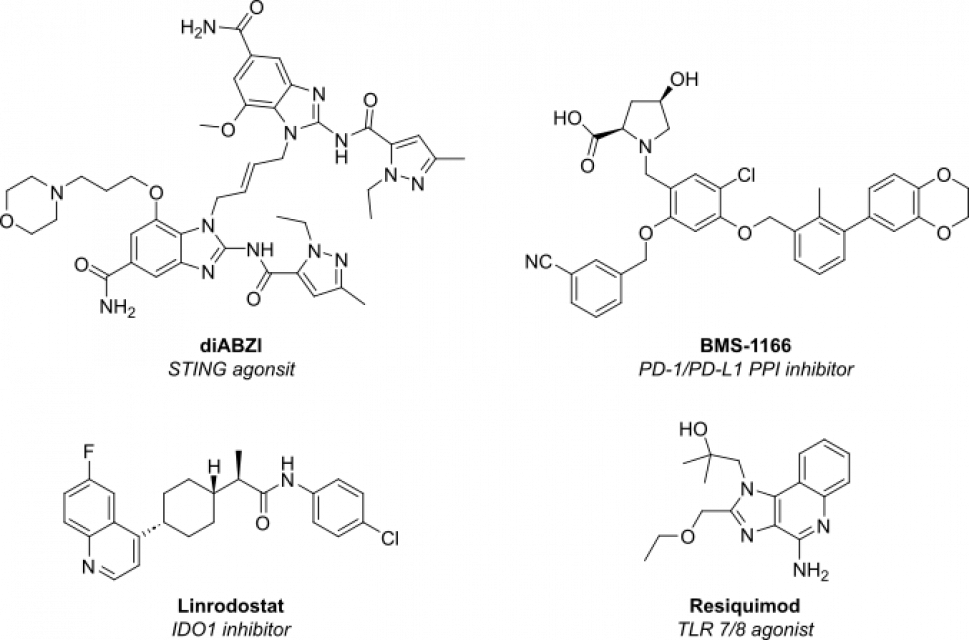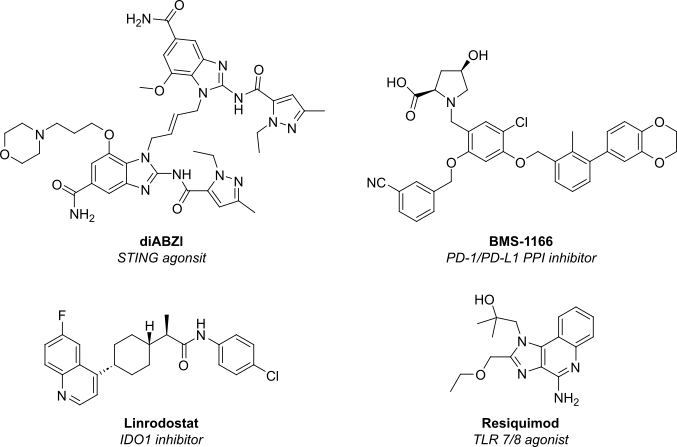
Advancing Cancer Drug Development: A 2025 Snapshot of the Small-Molecule Oncology Drug Pipeline
Table of Contents
Introduction: From Cancer Drug Discovery to Robust Drug Pipeline
Immuno-Oncology Drug Development
While checkpoint-blocking antibodies continue to dominate clinical headlines, a new generation of immuno oncology drugs in development are small molecules designed to modulate innate and adaptive immunity with oral or intratumoral dosing:
| Mechanism | Example of small-molecule (stage) | Rationale |
|---|---|---|
| STING agonist | di-ABZI (phase I) | Activate cGAS–STING pathway to boost type I IFN secretion and T-cell priming. |
| TLR7/8 agonist | BDB001 (phase II) | Intravenous TLR stimulation to inflame “cold” tumors. |
| IDO1 inhibitors | Linrodostat (phase III) | Restore tryptophan metabolism and reverse immune suppression. |
| Small-molecule PD-1/PD-L1 blockers | BMS-1166 (pre-clinical) | Oral immuno-checkpoint inhibition promises better tissue penetration. |

Figure 1: Structure of next-generation immune oncology small molecules currently undergoing clinical trials.
These approaches underscore an ongoing shift in immuno oncology drug discovery toward chemical matter that can be combined with antibodies, antibody-drug conjugates, or radioligands for synergistic efficacy.
State-of-the-art Cancer Drug Design
Modern anti cancer drug design leverages high-resolution structural biology, AI-enabled property prediction, and in-silico ADME-Tox modeling to compress timelines in the development of anticancer drugs:
- Screening of millions of compounds – DEL screening allows for the identification of high-affinity compounds from a single round of screening. Visit our services here.
- Structure-Guided Modeling – Cryo-EM structures of e.g. KRAS and RAF complexes have guided ras targeted drug development to picomolar affinity. Generative AI – Transformer-based models propose synthetically tractable scaffolds for “difficult” pockets (e.g. β-catenin) within days.
- Covalent fragment growing – Used to create first-in-class covalent KRAS (G12C) inhibitors, demonstrating the power of anti cancer drug discovery that combines warhead chemistry with macromolecular insight.
- Macrocycle Design – Enables oral inhibition of allosteric mutant p53 re-activators, expanding the druggable proteome.
Collectively, these tools accelerate cancer drug design and discovery from hit identification to IND in <24 months—a milestone once reserved for antivirals.
Recent Highlights in Cancer Drug Discovery & Development
KRAS (G12C) – Prototype for undruggable success
- Sotorasib gained global approval for the treatment of non-small-cell lung cancer (NSCLC) in 2021.
- Adagrasib secured accelerated FDA approval and is under study in colorectal cancer (CRC).
Tissue-Agnostic Therapies
- The approval of Larotrectinib for NTRK-fusion tumors illustrates tissue agnostic drug development in oncology.
Hematologic Malignancies
- Venetoclax (BCL-2 inhibitor) transformed therapy for both Chronic Lymphocytic Leukemia (CLL) and Acute Myeloid Leukemia (AML) drugs in development
- Ivosidenib (IDH1 inhibitor) exemplifies targeted therapy in AML and cholangiocarcinoma
Solid-Tumor Snapshot
| Indication | Small-Molecule Class | Examples | Development Stage (2025) |
|---|---|---|---|
| Bladder cancer drugs in development | FGFR2/3 inhibitors | Erdafitinib | Approved |
| Glioblastoma drugs in development | PP2A activators | NZ-8-061 | Preclinical |
| Ovarian cancer drugs in development | ATR inhibitor + PARP inhibitor | Camonsertib | Phase II |
| Lung cancer drugs in development | HER2 exon 20 inhibitors | Poziotinib | Phase II |
| Prostate cancer pipeline | CYP17-lyase and AR inhibitor | Seviteronel | Phase II |
DEL Screening: Accelerating Novel Binder Identification
DEL Screening marries combinatorial chemistry with next-generation sequencing (NGS), enabling the interrogation hundreds of millions of unique compounds in a single experiment. Key benefits for cancer target discovery and development include:
- Speed – hit emerge in weeks, shrinking the early cancer drug discovery research timeline.
- Novel chemotypes – DEL campaigns routinely identify scaffolds absent from commercial collections.
- Diverse targets – successful against E3 ligases (PROTAC starting points), kinases, proteases, epigenetic readers and more all enriching the new cancer drug discovery toolkit.
Read more about Vipergen’s DNA Encoded Libraries and Screening.
Conclusion
The current wave of anticancer drug development is defined by:
- Precision-guided cancer medicine discovery for ever-smaller molecular sub-populations.
- Convergence of DEL screenings, AI, and structural biology to shorten the cancer drug development process.
- Expansion of oncology drugs in development from tumor-specific to tissue-agnostic labels.
- Synergistic combinations of immune oncology drug development with targeted small molecules.
For stakeholders charting the cancer drug pipeline – from venture investors to clinical researchers – the opportunity is unprecedented. Tomorrow’s first-in-class agents will likely emerge from agile teams that integrate data science, chemistry, and translational biology into a seamless discovery-to-clinic continuum.
Key References
- Drilon, A. et. al. Efficacy of Larotrectinib in TRK Fusion-Positive Cancers in Adults and Children., N. Engl. J. Med., 2018, 378, 731-739. doi.org/ 10.1056/NEJMoa1714448
- Kamb, A., Wee, S., Lengauer, L. Why is cancer drug discovery so difficult? Nat. Rew. Drug Discov., 2007, 6, 115-120. doi.org/10.1038/nrd2155
- Lyou, Y. et. al. Infigratinib in Early-Line and Salvage Therapy for FGFR3-Altered Metastatic Urothelial Carcinoma, Clin. Genitourin. Cancer, 2022, 20 (1), 35-42. doi.org/10.1016/j.clgc.2021.10.004
- Qiu, X. et. al. Advances in AI for Protein Structure Prediction: Implications for Cancer Drug Discovery and Development, Biomolecules, 2024, 14 (3), 339. doi.org/10.3390/biom14030339
- Skoulidis, F. et. al. Sotorasib for Lung Cancers with KRAS p.G12C Mutation, N. Engl. J. Med., 2021, 384, 2371-2381. doi.org/10.1056/NEJMoa2103695
- Yap, T. A. et. al. Camonsertib in DNA damage response-deficient advanced solid tumors: phase 1 trial results, Nat. Med. 2023, 29, 1400-1411. doi.org/10.1038/s41591-023-02399-0

